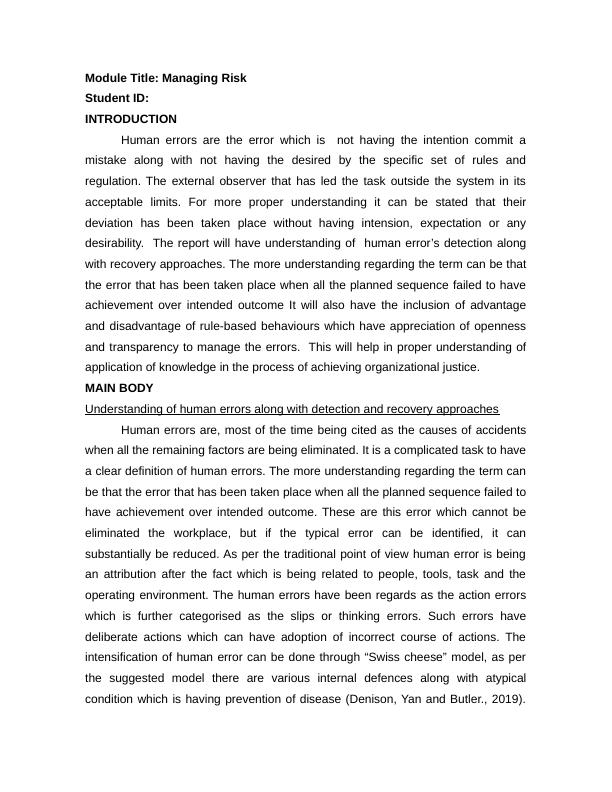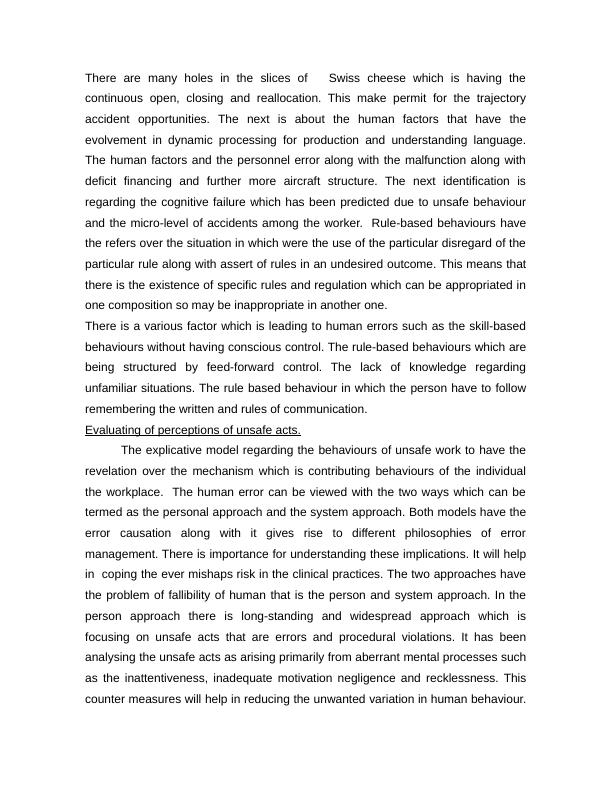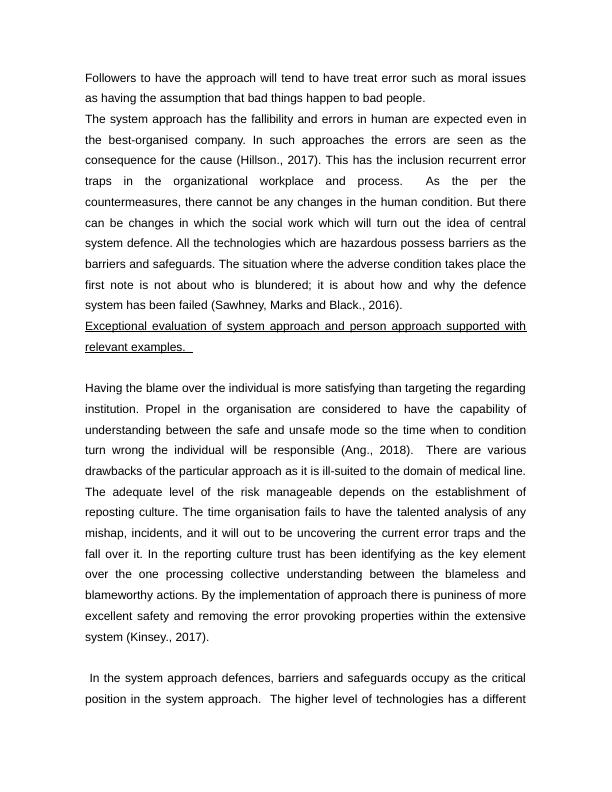Managing Risk: Understanding Human Errors and Recovery Approaches
8 Pages2962 Words46 Views
Added on 2023-01-19
About This Document
This report provides insights into human errors, detection, and recovery approaches in managing risk. It discusses the advantages and disadvantages of rule-based behaviors and explores the concept of just culture and its impact on organizational justice.
Managing Risk: Understanding Human Errors and Recovery Approaches
Added on 2023-01-19
ShareRelated Documents
Module Title: Managing Risk
Student ID:
INTRODUCTION
Human errors are the error which is not having the intention commit a
mistake along with not having the desired by the specific set of rules and
regulation. The external observer that has led the task outside the system in its
acceptable limits. For more proper understanding it can be stated that their
deviation has been taken place without having intension, expectation or any
desirability. The report will have understanding of human error’s detection along
with recovery approaches. The more understanding regarding the term can be that
the error that has been taken place when all the planned sequence failed to have
achievement over intended outcome It will also have the inclusion of advantage
and disadvantage of rule-based behaviours which have appreciation of openness
and transparency to manage the errors. This will help in proper understanding of
application of knowledge in the process of achieving organizational justice.
MAIN BODY
Understanding of human errors along with detection and recovery approaches
Human errors are, most of the time being cited as the causes of accidents
when all the remaining factors are being eliminated. It is a complicated task to have
a clear definition of human errors. The more understanding regarding the term can
be that the error that has been taken place when all the planned sequence failed to
have achievement over intended outcome. These are this error which cannot be
eliminated the workplace, but if the typical error can be identified, it can
substantially be reduced. As per the traditional point of view human error is being
an attribution after the fact which is being related to people, tools, task and the
operating environment. The human errors have been regards as the action errors
which is further categorised as the slips or thinking errors. Such errors have
deliberate actions which can have adoption of incorrect course of actions. The
intensification of human error can be done through “Swiss cheese” model, as per
the suggested model there are various internal defences along with atypical
condition which is having prevention of disease (Denison, Yan and Butler., 2019).
Student ID:
INTRODUCTION
Human errors are the error which is not having the intention commit a
mistake along with not having the desired by the specific set of rules and
regulation. The external observer that has led the task outside the system in its
acceptable limits. For more proper understanding it can be stated that their
deviation has been taken place without having intension, expectation or any
desirability. The report will have understanding of human error’s detection along
with recovery approaches. The more understanding regarding the term can be that
the error that has been taken place when all the planned sequence failed to have
achievement over intended outcome It will also have the inclusion of advantage
and disadvantage of rule-based behaviours which have appreciation of openness
and transparency to manage the errors. This will help in proper understanding of
application of knowledge in the process of achieving organizational justice.
MAIN BODY
Understanding of human errors along with detection and recovery approaches
Human errors are, most of the time being cited as the causes of accidents
when all the remaining factors are being eliminated. It is a complicated task to have
a clear definition of human errors. The more understanding regarding the term can
be that the error that has been taken place when all the planned sequence failed to
have achievement over intended outcome. These are this error which cannot be
eliminated the workplace, but if the typical error can be identified, it can
substantially be reduced. As per the traditional point of view human error is being
an attribution after the fact which is being related to people, tools, task and the
operating environment. The human errors have been regards as the action errors
which is further categorised as the slips or thinking errors. Such errors have
deliberate actions which can have adoption of incorrect course of actions. The
intensification of human error can be done through “Swiss cheese” model, as per
the suggested model there are various internal defences along with atypical
condition which is having prevention of disease (Denison, Yan and Butler., 2019).

There are many holes in the slices of Swiss cheese which is having the
continuous open, closing and reallocation. This make permit for the trajectory
accident opportunities. The next is about the human factors that have the
evolvement in dynamic processing for production and understanding language.
The human factors and the personnel error along with the malfunction along with
deficit financing and further more aircraft structure. The next identification is
regarding the cognitive failure which has been predicted due to unsafe behaviour
and the micro-level of accidents among the worker. Rule-based behaviours have
the refers over the situation in which were the use of the particular disregard of the
particular rule along with assert of rules in an undesired outcome. This means that
there is the existence of specific rules and regulation which can be appropriated in
one composition so may be inappropriate in another one.
There is a various factor which is leading to human errors such as the skill-based
behaviours without having conscious control. The rule-based behaviours which are
being structured by feed-forward control. The lack of knowledge regarding
unfamiliar situations. The rule based behaviour in which the person have to follow
remembering the written and rules of communication.
Evaluating of perceptions of unsafe acts.
The explicative model regarding the behaviours of unsafe work to have the
revelation over the mechanism which is contributing behaviours of the individual
the workplace. The human error can be viewed with the two ways which can be
termed as the personal approach and the system approach. Both models have the
error causation along with it gives rise to different philosophies of error
management. There is importance for understanding these implications. It will help
in coping the ever mishaps risk in the clinical practices. The two approaches have
the problem of fallibility of human that is the person and system approach. In the
person approach there is long-standing and widespread approach which is
focusing on unsafe acts that are errors and procedural violations. It has been
analysing the unsafe acts as arising primarily from aberrant mental processes such
as the inattentiveness, inadequate motivation negligence and recklessness. This
counter measures will help in reducing the unwanted variation in human behaviour.
continuous open, closing and reallocation. This make permit for the trajectory
accident opportunities. The next is about the human factors that have the
evolvement in dynamic processing for production and understanding language.
The human factors and the personnel error along with the malfunction along with
deficit financing and further more aircraft structure. The next identification is
regarding the cognitive failure which has been predicted due to unsafe behaviour
and the micro-level of accidents among the worker. Rule-based behaviours have
the refers over the situation in which were the use of the particular disregard of the
particular rule along with assert of rules in an undesired outcome. This means that
there is the existence of specific rules and regulation which can be appropriated in
one composition so may be inappropriate in another one.
There is a various factor which is leading to human errors such as the skill-based
behaviours without having conscious control. The rule-based behaviours which are
being structured by feed-forward control. The lack of knowledge regarding
unfamiliar situations. The rule based behaviour in which the person have to follow
remembering the written and rules of communication.
Evaluating of perceptions of unsafe acts.
The explicative model regarding the behaviours of unsafe work to have the
revelation over the mechanism which is contributing behaviours of the individual
the workplace. The human error can be viewed with the two ways which can be
termed as the personal approach and the system approach. Both models have the
error causation along with it gives rise to different philosophies of error
management. There is importance for understanding these implications. It will help
in coping the ever mishaps risk in the clinical practices. The two approaches have
the problem of fallibility of human that is the person and system approach. In the
person approach there is long-standing and widespread approach which is
focusing on unsafe acts that are errors and procedural violations. It has been
analysing the unsafe acts as arising primarily from aberrant mental processes such
as the inattentiveness, inadequate motivation negligence and recklessness. This
counter measures will help in reducing the unwanted variation in human behaviour.

Followers to have the approach will tend to have treat error such as moral issues
as having the assumption that bad things happen to bad people.
The system approach has the fallibility and errors in human are expected even in
the best-organised company. In such approaches the errors are seen as the
consequence for the cause (Hillson., 2017). This has the inclusion recurrent error
traps in the organizational workplace and process. As the per the
countermeasures, there cannot be any changes in the human condition. But there
can be changes in which the social work which will turn out the idea of central
system defence. All the technologies which are hazardous possess barriers as the
barriers and safeguards. The situation where the adverse condition takes place the
first note is not about who is blundered; it is about how and why the defence
system has been failed (Sawhney, Marks and Black., 2016).
Exceptional evaluation of system approach and person approach supported with
relevant examples.
Having the blame over the individual is more satisfying than targeting the regarding
institution. Propel in the organisation are considered to have the capability of
understanding between the safe and unsafe mode so the time when to condition
turn wrong the individual will be responsible (Ang., 2018). There are various
drawbacks of the particular approach as it is ill-suited to the domain of medical line.
The adequate level of the risk manageable depends on the establishment of
reposting culture. The time organisation fails to have the talented analysis of any
mishap, incidents, and it will out to be uncovering the current error traps and the
fall over it. In the reporting culture trust has been identifying as the key element
over the one processing collective understanding between the blameless and
blameworthy actions. By the implementation of approach there is puniness of more
excellent safety and removing the error provoking properties within the extensive
system (Kinsey., 2017).
In the system approach defences, barriers and safeguards occupy as the critical
position in the system approach. The higher level of technologies has a different
as having the assumption that bad things happen to bad people.
The system approach has the fallibility and errors in human are expected even in
the best-organised company. In such approaches the errors are seen as the
consequence for the cause (Hillson., 2017). This has the inclusion recurrent error
traps in the organizational workplace and process. As the per the
countermeasures, there cannot be any changes in the human condition. But there
can be changes in which the social work which will turn out the idea of central
system defence. All the technologies which are hazardous possess barriers as the
barriers and safeguards. The situation where the adverse condition takes place the
first note is not about who is blundered; it is about how and why the defence
system has been failed (Sawhney, Marks and Black., 2016).
Exceptional evaluation of system approach and person approach supported with
relevant examples.
Having the blame over the individual is more satisfying than targeting the regarding
institution. Propel in the organisation are considered to have the capability of
understanding between the safe and unsafe mode so the time when to condition
turn wrong the individual will be responsible (Ang., 2018). There are various
drawbacks of the particular approach as it is ill-suited to the domain of medical line.
The adequate level of the risk manageable depends on the establishment of
reposting culture. The time organisation fails to have the talented analysis of any
mishap, incidents, and it will out to be uncovering the current error traps and the
fall over it. In the reporting culture trust has been identifying as the key element
over the one processing collective understanding between the blameless and
blameworthy actions. By the implementation of approach there is puniness of more
excellent safety and removing the error provoking properties within the extensive
system (Kinsey., 2017).
In the system approach defences, barriers and safeguards occupy as the critical
position in the system approach. The higher level of technologies has a different

End of preview
Want to access all the pages? Upload your documents or become a member.
Related Documents
Human Error Essay (Solution)lg...
|12
|2604
|312
Managing Risk: Human Errors, Recovery Approaches, and Rule-Based Behaviorlg...
|13
|2803
|67
Managing Risk: Evaluating Human Fallibility and Just Culture at Rolls Roycelg...
|8
|1851
|24
Accident Analysis Techniqueslg...
|17
|3990
|225
Managing Safety & Security in Aviation: Importance of Human Factors and Risk Assessmentlg...
|5
|1566
|100
Impact of Workplace Environment on Health of Workerslg...
|12
|2450
|227
